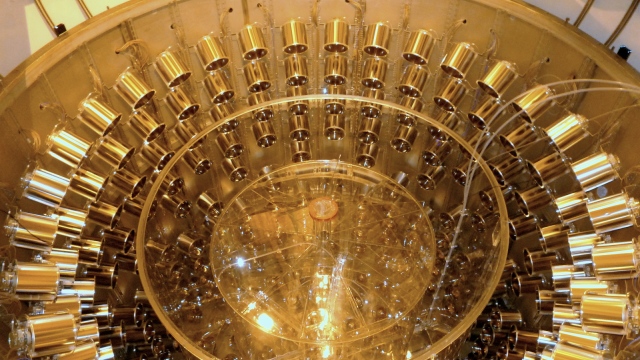
The Double Chooz (DC) experiment (based France) is based on an international collaboration from institutions from Brasil, Europe, Japan, Russia and US.

Double Chooz is a short-baseline neutrino oscillation experiment dedicated to the measure of θ13, the smallest mixing angle of the PMNS matrix. The experiment is situated at the nuclear reactor complex of Chooz, France, where two identical detectors measure the flux and spectra of the electron anti-neutrinos, emitted by the reactor cores, at two distances, one near (~400 m) and one far (~1 km).
To detect electron anti-neutrinos, the detectors relie on the Inverse Beta Decay reaction in which a hydrogen atom of the ~10 ton liquid scintillator volume is transformed into a positron and a neutron. This interaction results in two pulses of light which are detected by PhotoMultiplier Tubes which line the exteriour wall of each detector.

Electron anti-neutrinos oscillate, ie change flavour, as they travel, such that less electron anti-neutrinos are measured at the Far Detector than expected based on the flux measured at the Near Detector. This 'disappearance' of electron anti-neutrinos occurs at well known energies and produces a characteristic dip in the ratio of the spectra from the two detectors.
The Double Chooz experiment was constructed in two phases. First the Far Detector was built in an existing underground laboratory during the period 2008-2010. This detector began data-taking in spring 2011. Second, the excavation of the Near Detector laboratory began in 2011, the Near Detector was built during 2012-2013 and began data-taking from the end of 2014.
In the first phase of the experiment, with no Near Detector, the experiment relied on the prediction of the neutrino flux and spectrum emitted from the reactor cores. In November 2011, the Double Chooz collaboration announced a first hint of disappearance at the LowNu conference talk, given by H. de Kerret, and a measurement of sin^2 2θ13 = 0.086 +/- 0.041 (stat) +/- 0.030 (sys), ruling out the no-oscillation hypothesis with a 94.6% CL ref. Two additional data releases occuring during this phase, with the experiment improving its sensitivity as the statistics accumulated and techniques improved but limited by the systematics associated with the neutrino prediction.
The Near Detector began data-taking at the end of 2014. First results were announced in a seminar at CERN in 2016 by A. Cabrera, later at Neutrino 2018 and the first measurement published in Nature Physics in 2020. The experiment stopped data-taking at the end of 2017, having collected sufficient statistics. The latest results, exploiting the full data-set were announced at Neutrino 2020. These latest results give
sin^2 2θ13 = 0.102 +/- 0.004 (stat) +/- 0.011 (sys).

APC was one of the leading institutes of the experiment, participating on many critical activities in particular on the detector mechanics, electronics, Data Acquisition and analysis. APC members have also played key roles in the collaboration in particular the position of spokesperson which was held from 2003 to 2017 by our much-missed colleague H. de Kerret followed by A. Cabrera (the current spokesperson).
Historical list of APC staff involved
T. Akiri, W. Bertoli, A. Cabrera, B. Courty, J.V. Dawson, V. Durand, L. Fernando-Gonzalez, D. Franco, P. Gislain, A. Givaudan, H. Gomez, P. Guillouët, A. Hourlier, M. Karakac, H. de Kerret, D. Kryn , A. Lafitte, T. Lasserre, M. Obolensky, A. Onillon, A. Remoto, R. Roncin, B. Silva, F. Suekane, K. Terao, A. Tonazzo, D. Vincent, S. Wagner, S. Vydelingum
